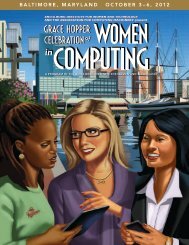ABI-ONE ghc program v14.indd - Grace Hopper Celebration of ...
ABI-ONE ghc program v14.indd - Grace Hopper Celebration of ...
ABI-ONE ghc program v14.indd - Grace Hopper Celebration of ...
Create successful ePaper yourself
Turn your PDF publications into a flip-book with our unique Google optimized e-Paper software.
GENERAL POSTER SESSION<br />
W e d n e s d ay | s e p T 3 0<br />
Integrating and Querying a Web <strong>of</strong><br />
Hybrid Data Using Wikitology<br />
Presenter: Zareen S. Syed (University <strong>of</strong><br />
Maryland, Baltimore County)<br />
The Web is mixture <strong>of</strong> interwoven<br />
networks <strong>of</strong> hybrid data such as free<br />
text, links, media, tables, triples etc. There<br />
is a need for new approaches for integrating<br />
information from heterogeneous sources<br />
and in heterogeneous representations.<br />
Through the development <strong>of</strong> Wikitology<br />
knowledge base derived from Wikipedia,<br />
we demonstrate a novel architecture for<br />
integrating structured and un-structured data<br />
and provide an integrated query interface to<br />
applications.<br />
Intrusion Detection System Using<br />
Support Vector Machine<br />
Presenter: Meenakshi Amirtharaj (Amrita<br />
Vishwa Vidyapeetham)<br />
Nowadays the need to classify legitimate<br />
users and intruders is <strong>of</strong> high priority.<br />
Support Vector Machines (SVM) is used for<br />
classification. Proximal SVM gives a wider<br />
margin by pushing the data points as far<br />
as possible, yielding better classification.<br />
Reduced SVM reduces the data set size and<br />
uses it for training, leading to less training<br />
time. Therefore the data set is reduced and<br />
feed into ProximalSVM. Feature selection is<br />
preformed. Efficient and faster classification<br />
is obtained.<br />
It Does What and It’s Shipping When!?<br />
Testing in an Experimental Environment<br />
Presenter: Lilia Paradis (Micros<strong>of</strong>t Live<br />
Labs)<br />
Testing for Micros<strong>of</strong>t Live Labs presents<br />
unique challenges. The Live Labs ethos<br />
involves experimentation on a small scale,<br />
taking place during quarterly innovation<br />
weeks. Whether and when to ship the<br />
projects that arise from experimentation is<br />
decided democratically.<br />
This poster describes the test problems<br />
and questions existing in Live Labs and the<br />
heuristics that our testers use to turn around<br />
quickly on the next cool thing.<br />
JCinema: S<strong>of</strong>tware for Producing<br />
Photorealistic Renderings <strong>of</strong><br />
Biomechanical Simulations<br />
Presenter: Spiridoula Lagaditis (University<br />
<strong>of</strong> British Columbia)<br />
My research focused on developing 3D<br />
visualization tools for s<strong>of</strong>tware that<br />
works as a bridge between a biomechanical<br />
simulator and an open source rendering<br />
engine to produce high-quality output. I<br />
developed a UI that produces the system in<br />
3D given a large data-set generated by the<br />
simulator which describes how the model<br />
interacts in a physical environment. The UI<br />
allows for user control and ease for further<br />
investigation.<br />
Jesus and the Jimson Weed - How Do<br />
We Derive Meaning from Tags, Text,<br />
and Queries to Support Improved Image<br />
Access?<br />
Presenter: Irene Eleta (University <strong>of</strong><br />
Maryland, College Park)<br />
Accessing images from on-line digital art<br />
collections remains challenging because<br />
traditional text-based search techniques are<br />
inadequate. Social tagging is a promising<br />
strategy for improving image retrieval in<br />
such collections. This poster examines<br />
how four areas <strong>of</strong> research - multi-lingual<br />
tagging, subject categorization <strong>of</strong> tags<br />
and queries, multi-word tags and terms,<br />
and behavioral approach to understanding<br />
search - shed light on this problem.<br />
Just a Spoonful <strong>of</strong> Sugar: Mitigating the<br />
Effects <strong>of</strong> Technology Change<br />
Presenter: Beverly Magda (Georgetown<br />
University)<br />
Because <strong>of</strong> a White House mandate<br />
for electronic health records by 2014,<br />
many hospitals are experiencing technology<br />
change at a fast pace. Technology projects<br />
notoriously have high failure rates and<br />
research has shown the top reasons why<br />
is not because <strong>of</strong> the technology itself, but<br />
because <strong>of</strong> human elements. This research<br />
examined benefits and application <strong>of</strong> leadership<br />
support, communication, training, and<br />
end-user involvement in hospital emergency<br />
departments implementing electronic<br />
healthcare records.<br />
Land Cover Change Detection Using<br />
Data Mining<br />
Presenter: Vasudha Mithal (Indian<br />
Institute <strong>of</strong> Technology, Kanpur)<br />
The land-cover-change-detection problem<br />
is one <strong>of</strong> detecting when the land cover<br />
at a given location has been converted from<br />
one type to another.<br />
The data used in this problem is the<br />
timeseries <strong>of</strong> FPAR(spectral measure <strong>of</strong><br />
the amount <strong>of</strong> vegetation) for different<br />
geographical locations. The idea is to<br />
develop algorithms which take advantage<br />
<strong>of</strong> the inherent characteristics <strong>of</strong> spatiotemporal<br />
data and are scalable i.e. suitable<br />
for high-resolution earth science datasets.<br />
Language Detection Using Hidden<br />
Markov Models - Optimized Algorithm<br />
for Wikipedia Pages<br />
Presenter: Rajitha Rani Satharla<br />
(Autozone)<br />
We intend to solve the problem <strong>of</strong><br />
language detection -determining<br />
if given text is in a particular language or<br />
not. We designed and implemented an<br />
algorithm that can extract Wikipedia pages<br />
<strong>of</strong> a given language, parse the HTML to<br />
retrieve content <strong>of</strong> that particular language.<br />
While automatically filtering out unnecessary<br />
and redundant content, and Model that<br />
language as a hidden Markov model for easy<br />
detection using an optimized algorithm that<br />
works with bigrams.<br />
56 Anita Borg Institute for Women and Technology | <strong>Grace</strong> <strong>Hopper</strong> <strong>Celebration</strong> <strong>of</strong> Women in Computing




